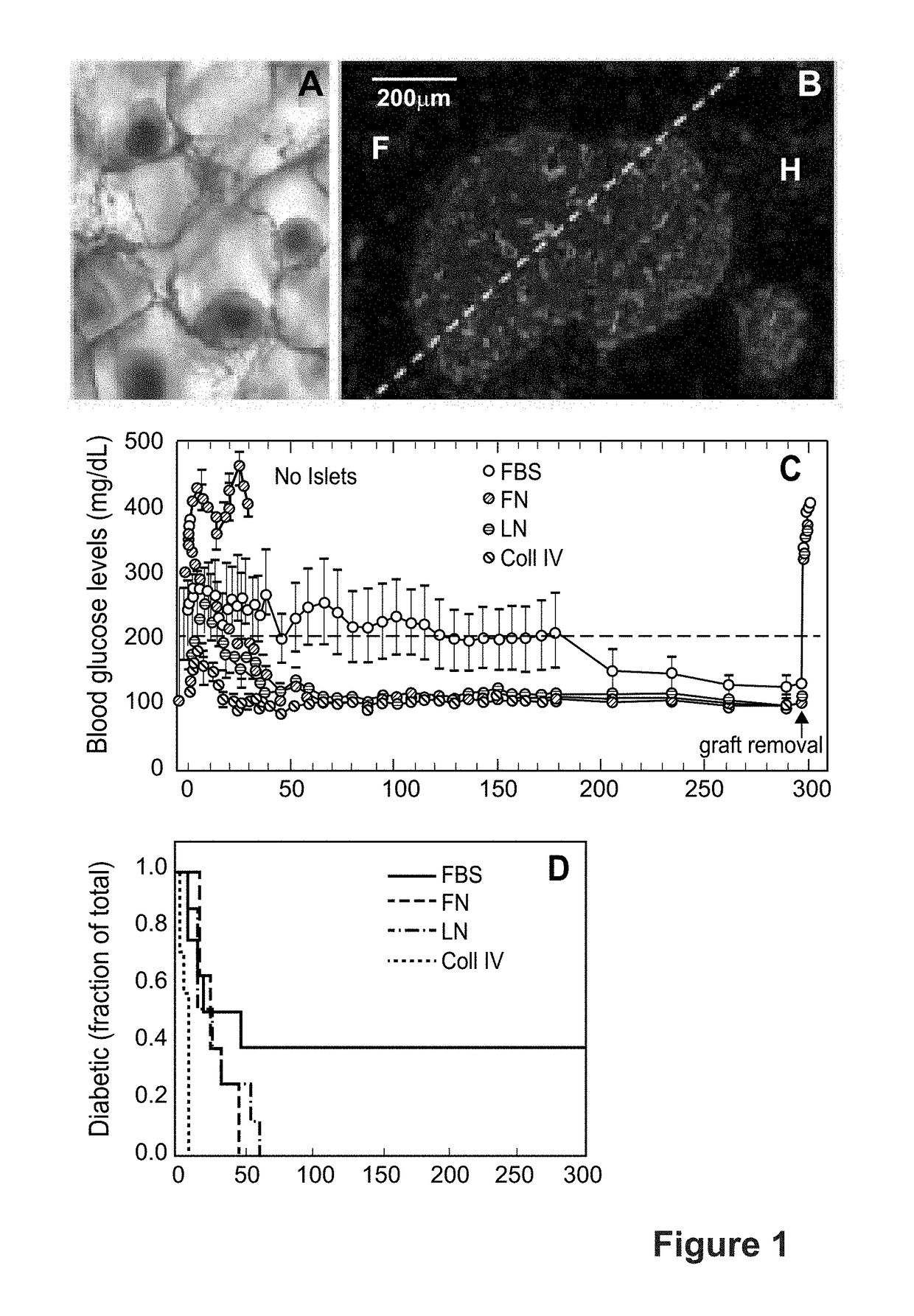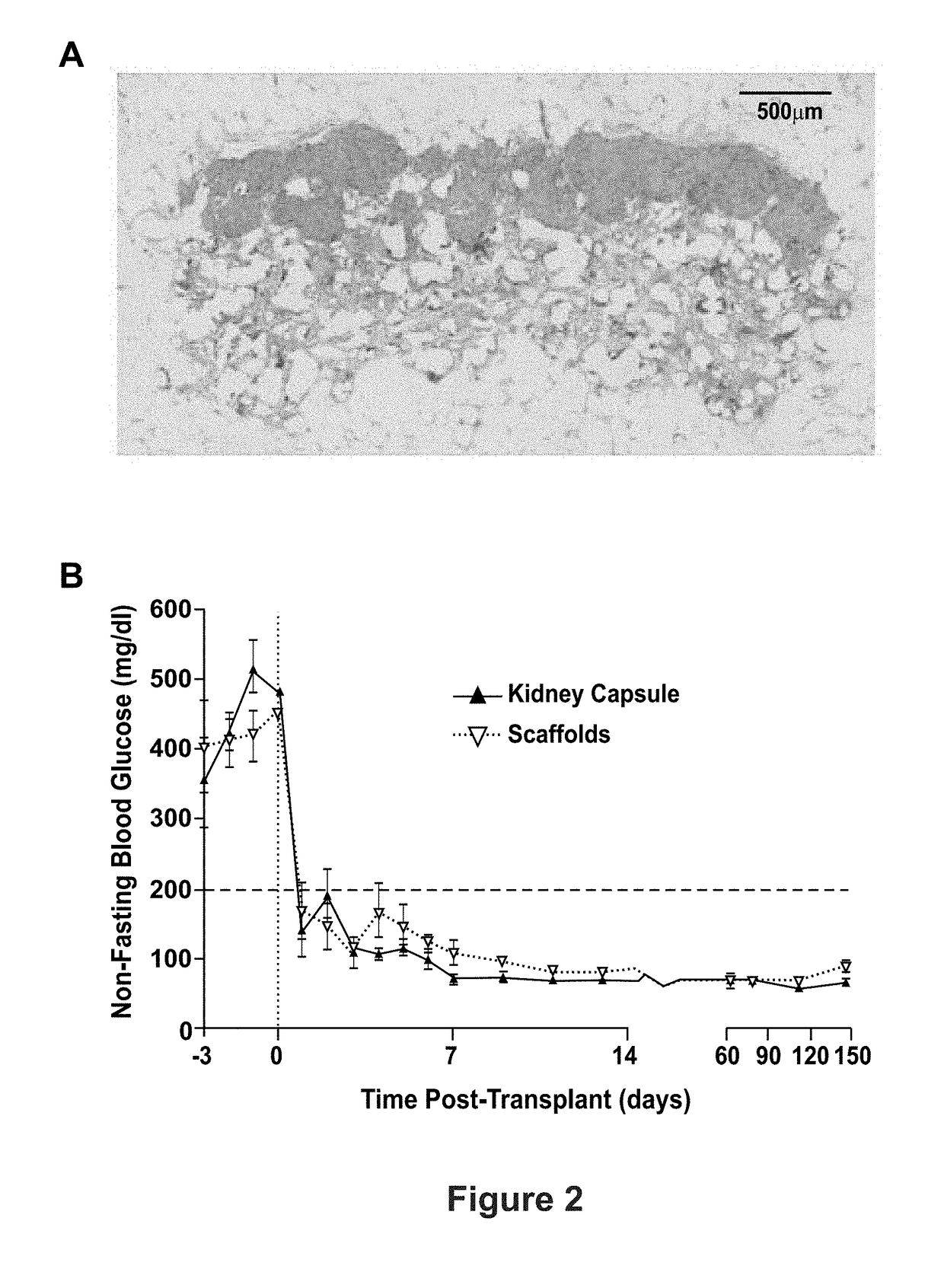Microporous Hydrogel Scaffolds for Cell Transplantation
- Summary
- Abstract
- Description
- Claims
- Application Information
AI Technical Summary
Benefits of technology
Problems solved by technology
Method used
Image
Examples
example 1
Microporous Scaffolds Support Engraftment of Mouse and Human Islets
[0080]Microporous scaffolds for transplantation of islets into epididymal fat pads have been developed, which are clinically equivalent to the omentum [Blomeier et al., Transplantation. 2006; 82:452-9.]. Mouse islets seeded onto the microporous scaffolds quickly distributed within the scaffold pores, with 1-2 islets per pore (FIG. 1A). Fourteen days after implantation into a syngeneic host, islets were seen to maintain their morphology, demonstrate a dense and functional vasculature (staining for tomato lectin) (FIG. 1B), and additionally contain proliferating cells as indicated by PCNA staining, suggesting that turnover and remodeling were occurring within the islets (data not shown) [Gibly et al., Biomaterials. 2011; 32:9677-84]. The engrafted islets reversed host diabetes for 300 days (FIG. 1C), and hyperglycemia returned after explant of the fat pad (FIG. 1C). Interestingly, the scaffold lost integrity around 100...
example 2
[0085]In some aspects, the present disclosure is directed toward the use of poly(ethylene glycol) (PEG) microporous scaffolds as a safe, efficient, and clinically applicable approach for transplantation of islets or hESC-derived n-cell progenitors. Questions examined in the examples relate to the scaffold design needed to create a supportive environment that maximally promotes engraftment and function of transplanted islets, or maturation of hESC-derived n-cell progenitors and subsequent normalization of blood glucose levels. Furthermore, the scaffolds are non-degradable which allows the implant to be explanted should the need arise; accordingly, these studies also assessed the efficacy of explantation at recovering transplanted cells.
[0086]Research over the past 10 years with microporous scaffolds has demonstrated that transplanted islets engraft, become revascularized, and function to maintain normal blood glucose levels for long times (FIG. 1C). These scaffolds have supported the...
example 3
Investigate Transplantation of Allogeneic Islets into the Peritoneal Fat on Microporous PEG Scaffolds for Long-Term Graft Function and Assess the Ability for Complete Graft Retrieval
[0087]In this example, results with microporous scaffolds are extended to investigate the potential for complete graft retrieval in rodent models, as well as the transplantation and retrieval of allogeneic islets delivered on scaffolds using a non-human primate model. Prior studies using microporous scaffolds composed of poly(lactic-co-glycolide) (PLG) or PEG indicate that this platform supports the efficient transplantation, engraftment, and function of transplanted islets. Both material platforms have had similar efficacy in islet transplantation, and can be functionalized (i.e., ECM proteins, trophic factors) in analogous manners (described below and Example 4). PEG-based microporous scaffolds are investigated as the material is expected to have a decreased inflammatory response relative to PLG, have ...
PUM
| Property | Measurement | Unit |
|---|---|---|
| Pore size | aaaaa | aaaaa |
| Diameter | aaaaa | aaaaa |
| Molecular weight | aaaaa | aaaaa |
Abstract
Description
Claims
Application Information
 Login to View More
Login to View More - R&D
- Intellectual Property
- Life Sciences
- Materials
- Tech Scout
- Unparalleled Data Quality
- Higher Quality Content
- 60% Fewer Hallucinations
Browse by: Latest US Patents, China's latest patents, Technical Efficacy Thesaurus, Application Domain, Technology Topic, Popular Technical Reports.
© 2025 PatSnap. All rights reserved.Legal|Privacy policy|Modern Slavery Act Transparency Statement|Sitemap|About US| Contact US: help@patsnap.com



